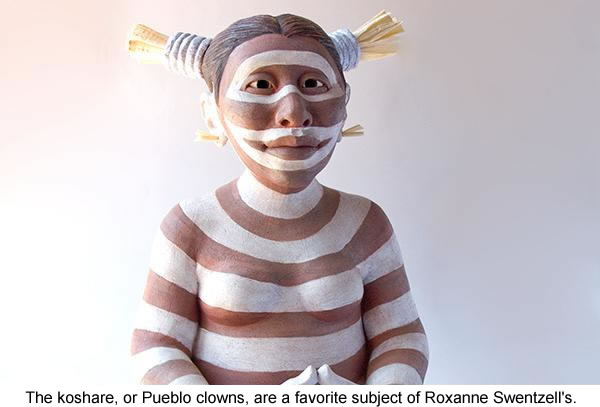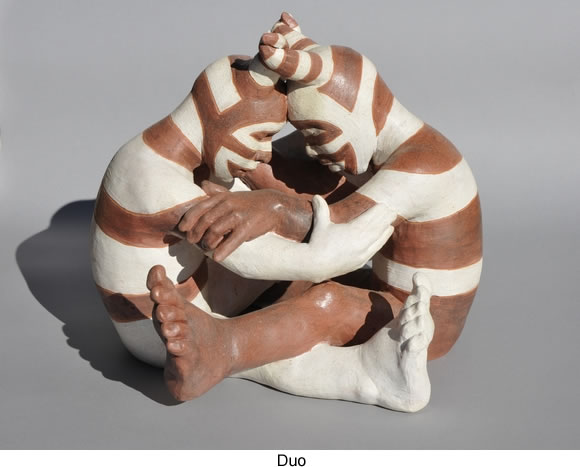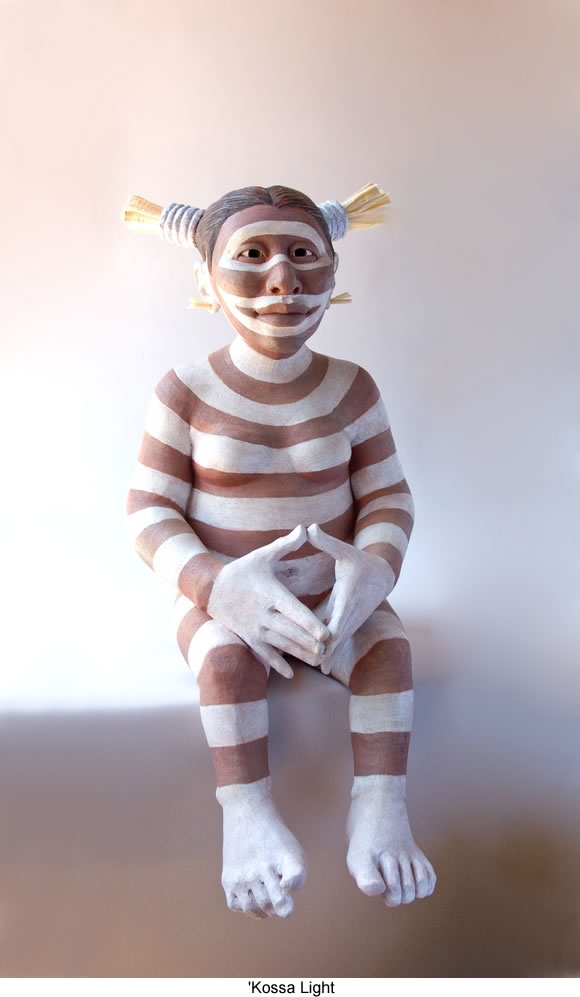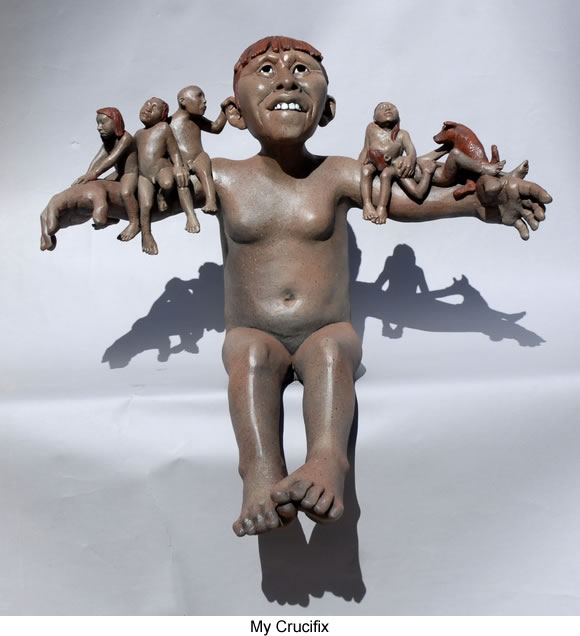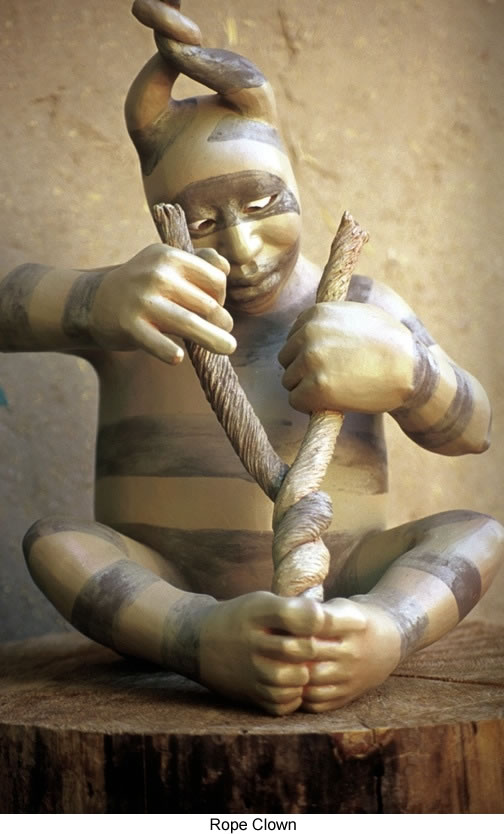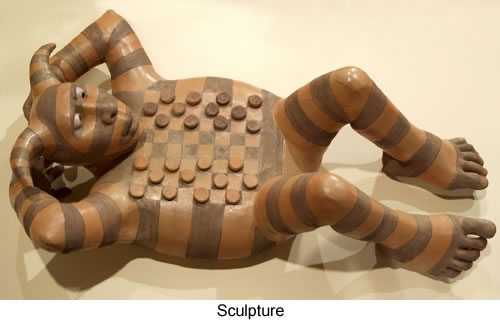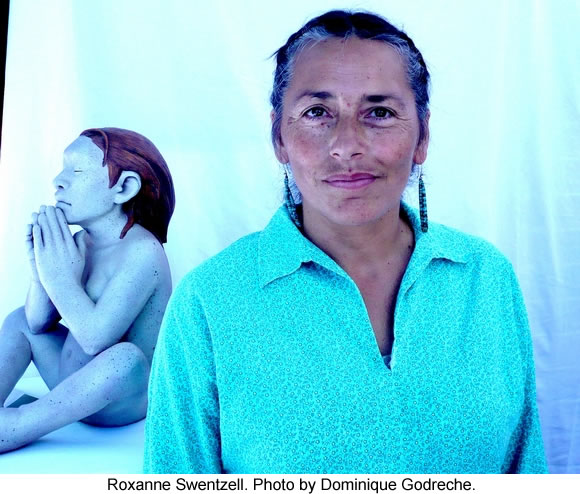 |
Canku Ota
|
 |
|
(Many Paths)
|
||
|
An Online Newsletter
Celebrating Native America
|
||
|
December 2013 - Volume
11 Number 12
|
||
|
|
||
|
Speaking With Clay,
Mud and Clowns: Pueblo Potter Roxanne Swentzell
|
||
|
by Dominique Godreche
- Indian Country Today Media Network
|
||
|
credits: except as noted:
all photos courtesy of Roxanne Swentzell
|
|
Roxanne Swentzell’s feminine koshare sculptures are well known in Santa Fe, where she exhibits at Tom Ross gallery, and her own Tower Gallery, in Pojoaque. A mother, grandmother, artist, gardener, and builder, Roxanne has pottery in her blood, and she took a few moments at the Santa Fe Indian Market to discuss her art with ICTMN.
How did you start your career as a sculptor? I come from a long lineage of Santa Clara Pueblo potters -- my mother was a potter, her mother was a potter, and so on. But for me, art was my first language: As a child, I had a speech impediment, and this language problem led me to create clay figurines, to express myself. That is how I started my art career: Trying to communicate. Today, these figures still tell my story -- even though I have learned to speak since then!
Why did you choose to represent the figure of the koshare? As a Pueblo woman, born in Taos, and raised in New Mexico, I have been part of that culture all my life, and my art reflects those influences. The koshares, the Pueblo clowns, serve to balance things in the pueblo. They relay messages to the community that other people cannot say, but the koshare can, better than anyone. The clowns reflect something people need to see about themselves. Like when someone is greedy: instead of shouting, the clown will sit in front of his house, and act like a greedy individual, collecting rocks -- and will transmit his message to that person by doing so. That is what I try to do in my work.
Your work is tightly related to clay and mud -- can you talk about your materials? I work with the clay, which I fire. But now, as a farmer, a builder, I am getting more raw with it -- my house is in adobe. Mud, adobe, are everywhere in my life: my hands are in mud all the time! So I want to merge them more. Building with adobe mud is exciting. But I can also sculpt with it -- there is something special about a well-crafted sculpture, made of dried mud, because it crosses boundaries. Usually, fine arts are removed from the ordinary, but making fine art with materials you can relate to is exciting. Starting from your backyard. That is why I chose to sculpt mud.
How do you see your evolution, as an artist? It is important to tell our own stories. We all have a story -- a profound, amazing journey in life. So, whenever I have caught the moment well enough, and have been present in that story, and in that moment -- that, to me, is a successful evolution.
|
|
|
||
|
|
||
| Canku Ota is a free Newsletter celebrating Native America, its traditions and accomplishments . We do not provide subscriber or visitor names to anyone. Some articles presented in Canku Ota may contain copyright material. We have received appropriate permissions for republishing any articles. Material appearing here is distributed without profit or monetary gain to those who have expressed an interest. This is in accordance with Title 17 U.S.C. Section 107. | ||
|
Canku Ota is a copyright ©
2000 - 2013 of Vicki Williams Barry and Paul Barry.
|
||
 |
 |
|
|
The "Canku
Ota - A Newsletter Celebrating Native America" web site and
its design is the
|
||
|
Copyright ©
1999 - 2013 of Paul C. Barry.
|
||
|
All Rights Reserved.
|
||
